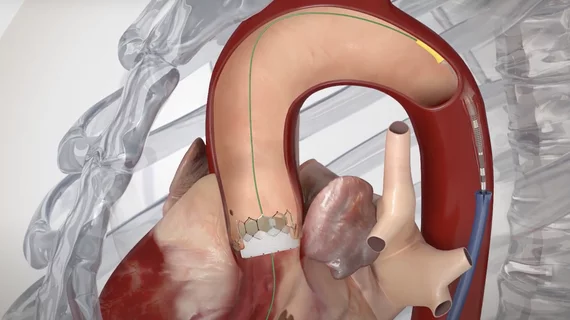TAVR associated with lower healthcare costs than surgery
Transcatheter aortic valve replacement (TAVR) is associated with lower healthcare costs after one year than surgical aortic valve replacement (SAVR), according to a new analysis published in Circulation: Cardiovascular Interventions.[1]
“With the use of TAVR expanding substantially, it is important to understand the evolving economic implications of this technology,” wrote first author Suzanne J. Baron, MD, MSc, of Lahey Hospital and Medical Center in Burlington, Mass., and colleagues. “Prior economic analyses have demonstrated that TAVR is cost-effective, although not cost-saving, compared with medical therapy in inoperable aortic stenosis patients and compared with SAVR in patients with AS at high surgical risk.”
Baron et al. tracked data from Medicare patients who underwent transfemoral TAVR or SAVR from 2016 to 2018. Patients who had been on Medicare less than six months at the time of treatment were excluded from the analysis.
Overall, more than 4,500 patients underwent TAVR and more than 3,500 underwent SAVR. While 1,500 SAVR patients underwent a combined cardiac procedure, the remaining patients underwent SAVR alone.
Among the TAVR group, the mean ages at the time of treatment were 79.8 years old for low-risk patients, 80.1 years old for intermediate-risk patients and 80.6. years old for high-risk TAVR patients. Among the SAVR group, the mean ages at the time of treatment were 71.8 years old among low-risk patients, 71.7 years old among intermediate-risk patients and 70.6 years old among high-risk patients. A higher percentage of female patients underwent TAVR than SAVR. A vast majority (84.6% to 93.6%, depending on the risk category and procedure) of patients were white.
Overall, index hospitalization costs were “significantly lower” among TAVR patients after one year. Among patients with a low Hospital Frailty Risk Score (HFRS), for example, the mean index costs were $61,845 for the TAVR group and $68,968 for the SAVR group. The same trend was seen among patients with an intermediate HFRS ($64,658 vs. $76,965) and a high HFRS ($65,594 vs. $91,005).
The key factor making SAVR costs higher, as one might expect, was the longer lengths of stay (LOS).
Follow-up costs were also higher among low-risk and intermediate-risk TAVR patients than low-risk and intermediate-risk SAVR patients — but there were “no significant differences” among high-risk patients.
The group noted that, when TAVR was first introduced, many economic studies concluded that it would likely be associated with higher costs. As the procedure has continued to evolve over time, however, it seems that it could be a more financially sound treatment decision than experts originally predicted.
“If long-term data continue to demonstrate similar clinical outcomes and valve durability with TAVR and SAVR, these findings suggest that TAVR may be the preferred treatment strategy for patients with aortic stenosis from an economic standpoint,” the authors wrote.
As of 2019, TAVR had surpassed SAVR in terms of the number or procedures performed.
Related TAVR content:
Amyloidosis patients can safely undergo TAVR
TAVR-related ischemic stroke linked to worse outcomes, higher Medicare costs
Time of day does not affect TAVR or SAVR outcomes
TAVR is safe and effective among asymptomatic patients, new research confirms
Find more structural heart news
Reference:

